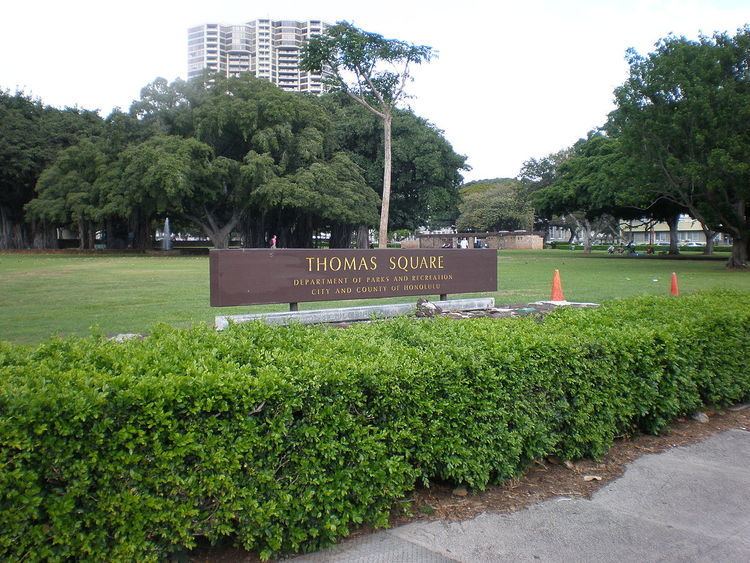NRHP Reference # 72000423 Year built 1843 Added to NRHP 25 April 1972 | Area 3 ha Phone +1 808-768-3003 | |
 | ||
Address 925 S Beretania St, Honolulu, HI 96814, USA Similar Neal S Blaisdell Center, Yoga Floats, Honolulu Zoo, Ala Wai Community Park, Diamond Head Bark Park | ||
Thomas Square is a park in Honolulu, Hawaii named for Admiral Richard Darton Thomas. The Privy Council voted to increase its boundaries on March 8, 1850, making Thomas Square the oldest city park in Hawaii.
Hawaii
In February 1843 Lord George Paulet on HMS Carysfort seized and occupied the Kingdom of Hawaii during the Paulet Affair.
On July 26 Admiral Richard Darton Thomas sailed into Honolulu harbor on his flagship HMS Dublin. He became Local Representative of the British Commission by out-ranking Paulet. His intention was to end the occupation. On July 31, he held the Hawaiian flag in his hands as he officially transferred the islands back to King Kamehameha III who said the words Ua Mau ke Ea o ka ʻĀina i ka Pono in a speech during a ceremony to mark his restoration. Roughly translated from the Hawaiian language it means "The sovereignty of the land is perpetuated in righteousness" and has become the state motto of Hawaii, incorporated into the Seal of Hawaii. The British flag set was pulled down and the Hawaiian flag was raised, followed by a series of 21 gun salutes from the Fort, the British ships Carysfort, Dublin, Hazzard, the American ship Constellation, and lastly by guns at the park.
Kamehameha III later named the place where the ceremony was held in Downtown Honolulu 21°18′9″N 157°50′56″W "Thomas Square" in Admiral Thomas's honor and dedicated it as a public park.
After the Privy Council demarcated Thomas Square's enlargement on March 8, 1850, the park was still merely a dusty field. A "cheap fence" was installed around 1873. Oats were sown and harvested and algaroba (kiawe) trees were planted soon after 1873, but there was still little shade at the park. It was around this time that the merchant Archibald Scott Cleghorn (husband of Princess Miriam Likelike, father of Princess Kaʻiulani, and brother-in-law of Kalākaua and Liliuokalani) began stewarding Thomas Square and Emma Square (the only two parks in Honolulu at that point). By 1883, Cleghorn had approved Robert Stirling's park design which laid out a series of circles and semi-circles for paths. Since Honolulu's treasury was in "dire condition" at the time, Cleghorn brought banyan trees from ʻĀinahau, his Waikiki estate, to plant and create more shade. He also asked his friends for money to design and build a bandstand, seating, and add more planting. Within several years, the bandstand was designed and installed by Mr. F. Wilhelm while more shrubs and trees were planted. The improved park celebrated a successful grand opening on April 7, 1887 where the Royal Hawaiian Band performed to a huge crowd.
In 1925 it was made into a park managed by the City and County of Honolulu.
In the early 1930s, the Parks Boards commissioned and adopted a renovation landscape plan by Catherine J. Richards and Robert O. Thompson. The renovation included a mock orange hedge along the curbs, flower beds bisecting a central walkway, and a terraces and coral wall parallel to Beretania Street. It was during this renovation period in 1932 that The Outdoor Circle donated the central memorial fountain, dedicating it to the late Beatrice Castle Newcomb, who had been the President of the Outdoor Circle from 1922 to 1929.
In 1938, The Daughters of Hawaii then unveiled a plaque to commemorate the historic flag-raising event.
In 1942, the US Army built barracks at Thomas Square to quarter troops during World War II. It received $50,000 in 1966 for a renovation that included an expanded comfort station, a new coral walkway from Beretania Street, and tree-pruning to thin out the canopies to allow for more light and air.
It was added to the National Register of Historic Places listings in Oahu on April 25, 1972. It is state historic site 80-14-9990.
Beginning in 2011, the Northern side of Thomas Square became an encampment site for (De)Occupy Honolulu, a Hawaiʻi affiliate of the Occupy movement. As such, regular protests and police conflicts have become a feature of the area.
July 31 is celebrated as Lā Ho'iho'i Ea or Restoration Day holiday. The pathways in the park are shaped in the form of the British flag. A fountain is in the center of the square, surrounded by trees. Across the street is the Honolulu Museum of Art.
